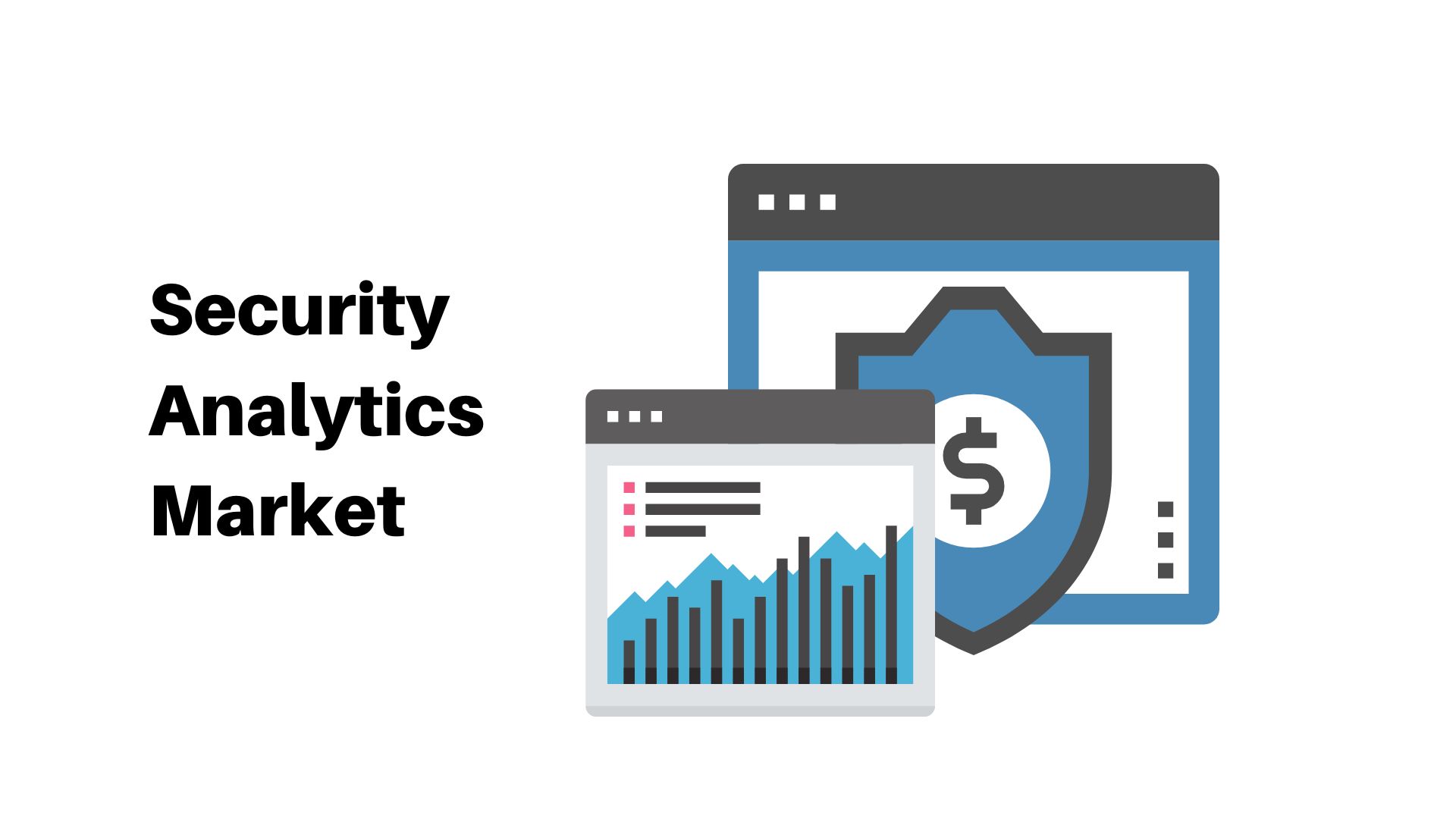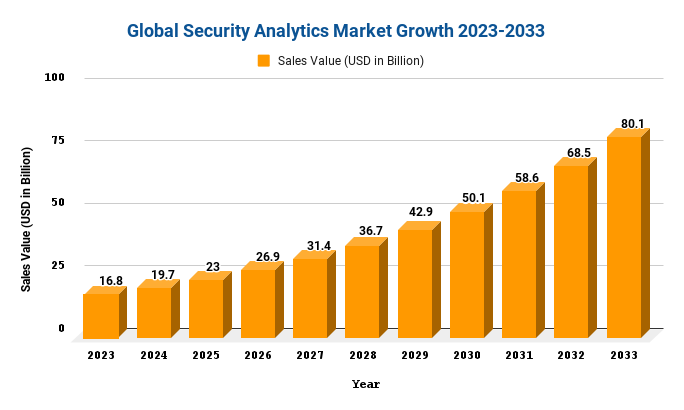Security Analytics Market Projected To Reach USD 80.11 Bn By 2033 | CAGR Of 16.9%

Page Contents
Market Overview
Published Via 11Press: Security Analytics is a rapidly growing sector of the cybersecurity industry. It applies advanced data analysis techniques like machine learning and artificial intelligence to detect and respond to cybersecurity threats. Organizations can benefit by purchasing software and services that monitor their networks, systems, and applications for signs of malicious activity. These tools analyze network traffic log data as well as other sources to detect potential issues and notify security teams to take action.
The security analytics market is being driven by regulations such as GDPR and CCPA, which mandate organizations to protect customers' personal data. There is thus an increasing need for tools that can quickly detect and address security incidents. Some key drivers of the security analytics market include an increasing sophistication in cyber attacks, an abundance of data generated by organizations, and the adoption of cloud-based services. In order to detect and address cyber-attacks appropriately, organizations need advanced tools.
Global Security Analytics Market Value at USD 16.81 Bn In 2023 and Is Projected To Reach USD 80.11 Bn By 2033, at a CAGR Of 16.9%.
Key Takeaways
- Security analytics is becoming a must-have within the cybersecurity industry, due to an uptick in both the number and sophistication of cyberattacks.
- The industry provides a suite of software and services to businesses so they can monitor their networks, systems, and applications for signs of malicious activity.
- Modern data analysis techniques are utilizing machine learning and artificial intelligence to enhance the precision and speed of security analytics solutions.
- The security analytics market is becoming increasingly crowded, with numerous vendors providing cutting-edge solutions to protect organizations' networks and data from cyberattacks.
- The market is being driven forward by factors such as the increasing adoption of cloud-based services, the vast amount of data generated by organizations and the need to adhere to data protection regulations.
- Organizations of all sizes have realized the advantages of security analytics in safeguarding their networks, systems and data from cyber threats and are investing in tools to bolster their security posture.
Request For Sample Report Here: https://marketresearch.biz/report/security-analytics-market/request-sample/
Regional Snapshot
- Security analytics is the leading market globally, driven by a high concentration of technology companies and an increasing frequency of cyber attacks. North American markets have experienced strong growth from within the United States alone.
- The European security analytics market is the second-largest, driven by data protection regulations such as GDPR. The United Kingdom, Germany and France are leading contributors to this growing sector within Europe.
- The Asia-Pacific security analytics market is experiencing rapid expansion due to the rising adoption of cloud-based services and growing awareness about cyber threats. China, Japan, and India are the three leading countries driving this rapid expansion.
- Security analytics is on the rise in Latin America, driven by increased technology adoption and growing awareness of cyber threats. Brazil and Mexico are leading countries contributing to this growing market.
- Security analytics is a rapidly developing market, driven by the increasing adoption of technology and an ever-increasing need for cybersecurity solutions. Saudi Arabia and the United Arab Emirates are two key contributors to this Middle East and Africa security analytics market.
Drivers
- A Growing Cyber Threat Landscape: Due to the rise of cyberattacks and their growing sophistication, organizations are searching for advanced security solutions to safeguard their sensitive data and infrastructure.
- Increased Adoption of Cloud Computing: Cloud computing has revolutionized how businesses operate, but it also presents new security risks. To combat these, companies are investing in security analytics solutions to monitor cloud-based environments.
- Regulatory Compliant: Government regulations such as GDPR, HIPAA and PCI-DSS necessitate organizations to implement robust security measures and regularly assess their security posture. Security analytics solutions assist companies in adhering to these regulations while avoiding expensive fines.
- Demand for Real-Time Threat Intelligence: As cyber-attacks become more sophisticated and frequent, companies require real-time threat intelligence to detect and respond promptly to potential risks. Security analytics solutions offer this insight, helping organizations stay ahead of potential hazards.
- Utilization of Big Data Analytics: Security analytics solutions utilize big data analytics to detect patterns and anomalies in network traffic, user behavior, and system logs. This enables organizations to detect potential threats and take proactive measures for prevention.
Restraints
- High Cost of Implementation: Security analytics solutions can be costly to implement, requiring substantial upfront investments in hardware, software and personnel. This may present a barrier for small and medium-sized businesses that may not have the budget for such initiatives.
- Lack of Experienced Security Professionals: Implementing security analytics solutions necessitates highly qualified security personnel to manage and analyze data. Unfortunately, there is a shortage of experienced personnel in the market, making it difficult for organizations to fully benefit from these solutions.
Opportunities
- Cloud-Based Security Analytics Gaining Popularity: As more businesses move their operations to the cloud, demand for cloud-based security analytics is also on the rise. Cloud solutions offer several advantages over on-premises options, such as flexibility and scalability, plus reduced costs.
- Rising Demand for Real-Time Threat Intelligence: With the growing volume and complexity of cyber threats, businesses require real-time threat intelligence to detect and respond promptly. This has sparked demand for security analytics solutions that offer real-time threat detection and response capabilities.
- Growth of IoT Devices and Security Threats: As the number of IoT devices grows, so too do their associated security threats. Security analytics solutions can help organizations monitor and secure their IoT assets by providing real-time threat detection and response capabilities.
- Advancements in machine learning and AI: Machine learning and AI technologies are increasingly being applied to security analytics solutions to enhance threat detection and response. As these technologies continue to develop, they are expected to fuel further growth within the security analytics market.
Ensure everything is in line with your specific requirements here: https://marketresearch.biz/report/security-analytics-market/#inquiry
Challenges
- Lack of Skilled Personnel: Security analytics requires specialized skills and expertise that are in short supply. Organizations are finding it challenging to hire and retain qualified personnel to manage their security analytics solutions.
- Cybercriminals are becoming more sophisticated, using advanced techniques to avoid detection. This means security analytics solutions must keep up with these evolving threats in order to be effective.
- Data Overload: Security analytics solutions generate vast amounts of data which may be difficult for organizations to manage and analyze. This makes it difficult to detect and respond promptly to security threats.
- Integration Challenges: Organizations often have multiple security solutions from different vendors, making it challenging to integrate and administer their security analytics solutions efficiently.
- High Cost: Security analytics solutions can be costly, especially for small and medium-sized businesses. This makes it difficult for organizations with limited budgets to implement effective security analytics programs.
Market Segmentation
Segmentation by Component:
- Software
- Managed Services
- Consulting Services
- Training & Education Services
- Support & Maintenance Services
Segmentation by Organization Size:
- Large Enterprises
- Small and Medium-Sized Enterprises
Segmentation by Deployment Mode:
- Cloud
- On-Premise
Segmentation by Industry Vertical:
- BFSI
- Healthcare
- Education
- IT & Telecom
- Manufacturing
- Transportation
- Energy & Utilities
- Government & Defense
- Retail and Consumer Goods
- Others (Food & Beverage, Oil & Gas,)
Key Players
- EMC RSA
- Fireeye, Inc.
- LogRhythm, Inc.
- Alien Vault, Inc.
- Cisco Systems, Inc.
- IBM Corporation
- Arbor Networks, Inc.
- Blue Coat Systems, Inc.
- Alert Logic, Inc. (Click Security)
- Hewlett-Packard Enterprise (HPE)
Report Scope
| Report Attribute | Details |
| Historical Years | 2017-2022 |
| Base Year | 2022 |
| Estimated Year | 2023 |
| Short-Term Projection Year | 2028 |
| Long-Term Projected Year | 2033 |
Recent Developments
- Increased Use of AI and Machine Learning: Security analytics solutions are increasingly utilizing AI and machine learning to detect and respond to security threats. These technologies can analyze vast amounts of data quickly, detecting patterns and anomalies which might otherwise go undetected by human analysts.
- Cloud-Based Security Analytics Gain Momentum: As more organizations move their security analytics solutions into the cloud, there is an increasing emphasis on cloud-based solutions due to their scalability, flexibility and cost-effectiveness. Cloud-based solutions offer several advantages over on-premise options including agility and cost efficiency.
- Growing Adoption of User and Entity Behavior Analytics (UEBA): UEBA is a technology that analyzes user and entity behavior to detect anomalous activity that could indicate security threats. It has become increasingly popular, as it can identify threats not detected by traditional security analytics solutions.
- Integration with Other Security Solutions: Security analytics solutions are being integrated with other security solutions, such as identity and access management (IAM) and security information and event management (SIEM). This combination provides a more comprehensive security platform that can detect and respond to threats more effectively.
- Focus on Compliance: Organizations face stringent regulatory compliance obligations that necessitate them to implement robust security solutions.
FAQ
Q: What is a Security Analytics Market Research Report?
A: A security analytics market research report is an extensive document that offers an in-depth study of the security analytics market, including market size, trends, growth factors, challenges and competitive landscape.
Q: What are the essential elements of a security analytics market research report?
A: Security analytics market research reports usually consist of an overview, market size and forecast, segmentation, competitive landscape, key players and growth drivers/challenges.
Q: What factors are driving the growth of the security analytics market?
A: Factors driving the growth of the security analytics market include an increasing volume and sophistication of cyber threats, the need for real-time threat detection and response, the growth of IoT devices with their associated security risks, as well as rising regulatory compliance requirements.
Q: What are some of the challenges confronting the security analytics market?
A: Some of the issues confronting this space include a shortage of skilled personnel, increasing sophistication of cyber threats, data overload issues, integration issues and high costs.
Q: Who are the major players in the security analytics market?
A: Major companies operating in this space include IBM Corporation, Cisco Systems, Inc., RSA Security LLC, Symantec Corporation, Splunk Inc., McAfee LLC LogRhythm Inc Rapid7 Inc FireEye Inc and Securonix Inc., among others.
Q: What are some of the trends in the security analytics market?
A: Trends within this space include increasing use of machine learning and AI, cloud-based solutions, user and entity behavior analytics (UEBA), as well as integration between security analytics solutions with other security products.
Q: What are the growth prospects for the security analytics market?
A: The security analytics market is forecasted to continue expanding rapidly, due to rising demand for advanced security solutions and evolving cyber threats. By 2024, this sector could reach several billion dollars in sales.
Contact us
Contact Person: Mr. Lawrence John
Marketresearch.Biz (Powered By Prudour Pvt. Ltd.)
Tel: +1 (347) 796-4335
Send Email: [email protected]
The team behind market.us, marketresearch.biz, market.biz and more. Our purpose is to keep our customers ahead of the game with regard to the markets. They may fluctuate up or down, but we will help you to stay ahead of the curve in these market fluctuations. Our consistent growth and ability to deliver in-depth analyses and market insight has engaged genuine market players. They have faith in us to offer the data and information they require to make balanced and decisive marketing decisions.




